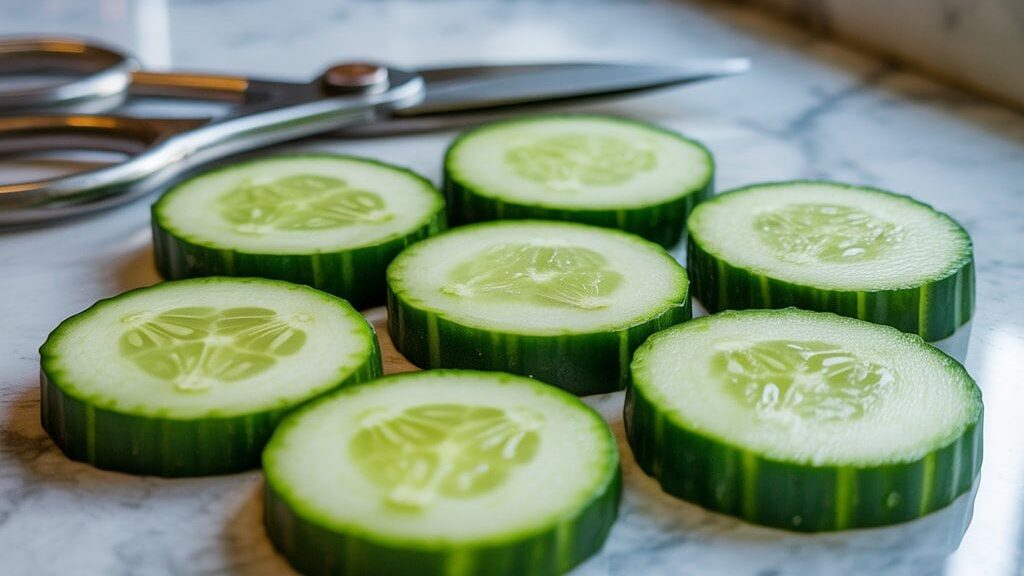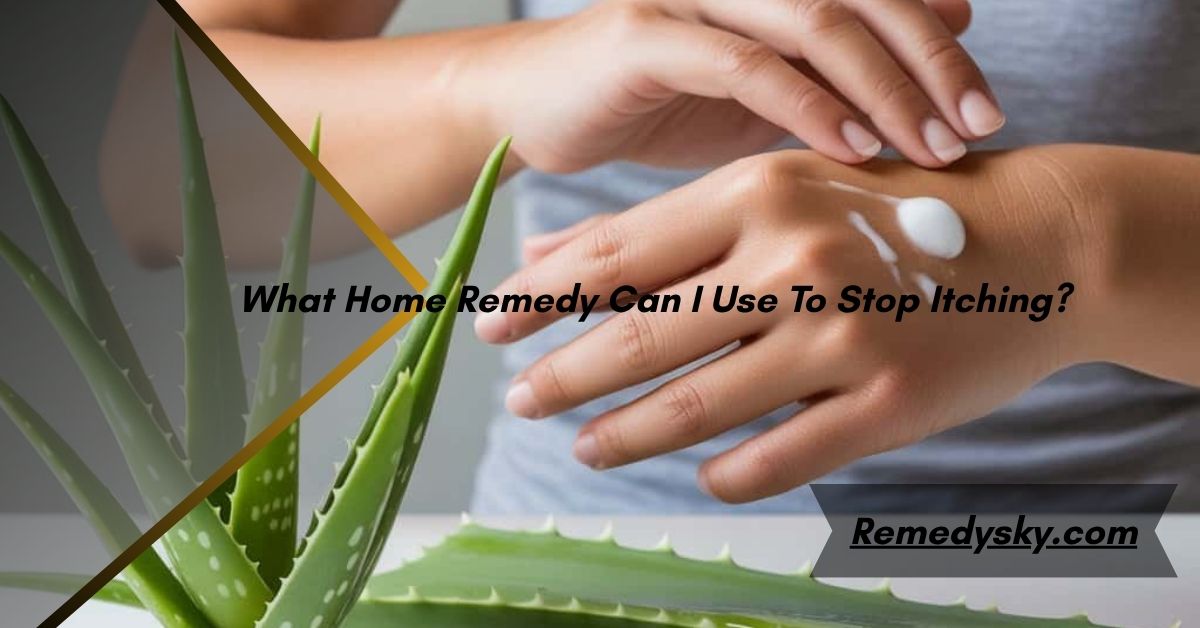I used to struggle with constant itching on my arms, and nothing worked. Then I tried applying fresh aloe vera gel daily, and it gave me real relief.
Itching can make your skin feel irritated, dry, or even painful. Many people deal with itching caused by dryness, bug bites, rashes, or sensitive skin. Sometimes it happens without a clear reason.
Instead of using strong creams or chemicals, many people prefer gentle home remedies that really work and are safe to use on a daily basis. If you’re asking yourself, “What home remedy can I use to stop itching?”—you’re in the right place.
Let’s go through each remedy step by step, using easy-to-understand advice and real ingredients that help calm the skin naturally
1. Cold Compress for Instant Relief
When your skin is hot, red, or irritated, it often becomes itchier. A cold compress helps bring down the heat and soothes the skin quickly. You don’t need anything fancy. Just wrap some ice cubes in a soft towel or use a bag of frozen vegetables from your freezer. Hold it gently on the itchy area for about 10 minutes.
This gives fast relief and also prevents you from scratching, which can make the skin worse. You can do this several times a day if the itching comes back.
2. Aloe Vera – Nature’s Skin Soother
Aloe vera is one of the best natural plants to use on itchy skin. The gel inside the leaf feels cool and refreshing when applied. It’s known to reduce redness, calm inflammation, and add moisture. If you have an aloe vera plant at home, just cut a leaf, squeeze out the clear gel, and rub it gently on the itchy skin.
Let it dry. If you don’t have a plant, you can buy pure aloe gel from any drugstore. Use it 2–3 times a day until the itching stops. It’s especially helpful for sunburn or dry skin patches.
3. Apple Cider Vinegar – A Natural Antiseptic
Apple cider vinegar is popular for many home uses, and it works well for skin problems too. It helps balance the skin’s pH and fights bacteria that can cause itching. Mix equal parts of apple cider vinegar and water. Use a cotton ball to dab it onto the itchy area.
You might feel a slight tingle, but it goes away fast. This works best on dry, flaky skin or mild rashes. If you have open cuts or sensitive skin, do a small patch test first to avoid stinging.
4. Oatmeal Soaks to Calm Irritated Skin
Plain oats you eat for breakfast can also help itchy skin. When turned into a bath soak, oatmeal becomes very calming and gentle. It protects the skin and keeps moisture locked in. To use it, grind one cup of oats into a fine powder using a blender, and sprinkle it into a tub of warm (not hot) water.
Soak for 15–20 minutes. Gently pat your skin dry afterward. This is a favorite remedy for kids and adults dealing with dry skin, chickenpox, or rashes.
5. Baking Soda to Relieve Itching
Baking soda is another simple remedy found in almost every kitchen. It has calming effects and can reduce swelling or redness caused by itching. To make a paste, mix 1 tablespoon of baking soda with a few drops of water until it becomes thick.
Gently spread it on the itchy spot. Let it sit for 10–15 minutes before rinsing off. This works well on itchy spots from bug bites or heat rashes. You can also add half a cup to your bathwater if you’re itching all over.
6. Coconut Oil for Deep Moisturizing
Coconut oil is a favorite remedy for many skin problems. It’s gentle, safe, and smells good too. The best kind is virgin coconut oil, which is full of natural fats that help keep your skin soft. After a shower, apply a small amount to the itchy area.
It helps reduce dryness and creates a protective layer on your skin. This is especially helpful for people with eczema, dry patches, or itchy feet in winter. Use it daily for smooth, calm skin.
Read More: What home Remedy can i give my Dog for Diarrhea?
7. Honey – A Sweet Remedy for Itchy Skin
Raw honey is not only good for sore throats but also helps your skin heal faster. It contains natural enzymes and moisture that calm irritated skin. Spread a small amount on the itchy area and leave it for 20 minutes before washing it off.
Honey reduces redness, cools the area, and helps fight off any tiny germs that may be causing the irritation. Use this remedy once or twice daily for best results. It’s safe even for children’s skin.
8. Tea Tree Oil for Itchy Bumps or Bites
Tea tree oil is a natural oil made from the leaves of a plant found in Australia. It has strong germ-fighting and calming properties. To use it safely, mix a few drops of tea tree oil with a tablespoon of coconut or olive oil.
Dab a little of this mix on the itchy skin using a cotton swab. It works well on bug bites, small rashes, or itchy red bumps. Don’t use pure tea tree oil directly—it can sting or irritate sensitive skin.
9. Cucumber Slices for a Cooling Effect

Cucumbers are cool and full of water. That makes them great for calming itchy or burning skin. Just take a fresh cucumber, slice it thin, and place the slices on the itchy area. Leave them on for about 15 minutes.
You’ll feel instant relief. This is very useful for puffy eyes, sunburns, or any area that feels hot and itchy. It’s also gentle enough to use on the face.
10. Olive Oil for Long-Lasting Skin Relief
Olive oil isn’t just for cooking—it’s also wonderful for dry, itchy skin. It has healthy fats and vitamins that soak into the skin and keep it smooth. After washing, massage a small amount of extra virgin olive oil into the itchy spots.
It helps your skin heal and keeps it soft for hours. Use it twice daily for best results. It’s a great option for older adults who have dry, sensitive skin that itches often.
11. Calendula—A Healing Herb
Calendula, also known as pot marigold, is a flower that’s been used for hundreds of years to calm skin problems. It helps reduce inflammation, swelling, and redness. You can use calendula cream from a store or make your own using dried petals and warm oil.
Gently apply it to the itchy area. It works well on scrapes, itchy rashes, or skin healing from sunburn. This herb is gentle and safe for most people.
12. Chamomile Tea Compress
Chamomile isn’t just a calming tea—it’s also calming for your skin. Brew a strong cup of chamomile tea, let it cool completely, and then soak a soft cloth in it. Place the damp cloth on the itchy skin and let it sit for 10 to 15 minutes.
The tea helps reduce swelling and soothes irritation. You can repeat this a few times a day as needed. This remedy is especially helpful if your skin is red and sensitive.
13. Peppermint Leaves or Oil
Peppermint has a cooling, numbing effect that helps stop the urge to scratch. You can crush fresh peppermint leaves and gently rub them on the skin, or you can use peppermint essential oil (always diluted).
Mix a few drops of oil with a carrier oil like almond or olive oil and apply to the itchy spot. The menthol gives a fresh, cool feeling that makes itching less noticeable. This is great for summer rashes or itchy feet.
14. Lemon Juice (Use with Caution)
Lemon juice has natural acids and antibacterial properties. It can help clean the skin and reduce itching from minor irritations. However, it can sting if your skin is cracked or raw. If you want to try it, squeeze a small amount of fresh lemon juice and apply gently using a cotton ball.
Rinse off after 5–10 minutes. Use this method only on non-sensitive areas like arms or legs, and always test on a small patch first.
15. Keep the Skin Moisturized
Itching often starts when the skin is too dry. Using a gentle, unscented moisturizer can help prevent the itch from coming back. Apply lotion right after showering while your skin is still damp. This helps lock in moisture.
Choose products made for sensitive skin or look for natural ingredients like shea butter, aloe vera, or oat extract. Moisturize at least twice a day for smooth and comfortable skin.
More Read: What is the Immediate Remedy for Shortness of Breath?
16. Avoid Scratching and Irritants
It’s hard not to scratch when you’re itchy, but scratching can hurt the skin more. Try tapping or gently pressing the itchy spot instead. Wear soft, loose clothes made from cotton. Avoid using strong soaps, perfumed lotions, or laundry products with harsh chemicals.
These can make itching worse, especially for people with eczema or allergies. Keeping your skin clean and protected goes a long way.
17. Stay Hydrated from the Inside

Drinking enough water is just as important as using creams. When your body is dehydrated, your skin dries out, making it itchy. Try to drink water regularly throughout the day.
Add lemon or cucumber slices for flavor if you don’t like plain water. Eating fruits like watermelon, oranges, and cucumbers also helps keep you hydrated from the inside out.
18. Try Witch Hazel for Soothing Skin
Witch hazel is a plant-based liquid that calms the skin. It’s often used on bug bites, rashes, or irritated spots. You can find it at most stores. Just pour a little on a cotton ball and dab gently on the itchy skin. It feels cool and helps reduce swelling. It’s especially useful for shaving rashes or underarm itching.
19. Use Cornstarch for Sweaty, Itchy Skin
If you’re dealing with itching caused by sweat, heat, or rubbing, cornstarch can help. It absorbs moisture and reduces friction. Lightly dust the itchy area with a small amount of cornstarch after drying off. It’s gentle and safe for daily use. This is often used in warm weather, under the arms, or between skin folds.
20. Understand When to See a Doctor
Most itching can be managed at home, but sometimes it’s a sign of something more serious. If the itching lasts more than a week, keeps getting worse, or comes with swelling, pain, or a rash that spreads fast, see a doctor.
If you’re unsure what’s causing the itch, it’s better to get a professional opinion. Also, if home remedies don’t bring relief after several days, medical treatment may be needed.
Conclusion:
Itching is something I’ve dealt with too, and I know how annoying it can be. But the good thing is, you don’t always need strong creams to feel better. Simple things like aloe vera, coconut oil, or even cold cucumber can help a lot. These home remedies are gentle and safe, and most of them are already in your kitchen.
I learned that keeping my skin clean, moisturized, and not scratching too much really helped. Trying these natural tips made my skin feel calm again. If your itching is light or comes and goes, these remedies are a great place to start. But if it doesn’t get better after a few days, it’s always smart to check with a doctor. Just take it one step at a time—your skin will thank you.
Read Related:
What home remedy is Good for a Dog with Bloody Diarrhea?
how to remove thick Dead skin from Feet home remedy?
how to remove blood stains from clothes home remedy
Efficient Natural Flea Treatments for Dogs
what to drink for heartburn relief home remedy
how to stop dog from licking paws home remedy
How to Remove Gas from Stomach Instantly
how to increase white blood cells home remedy

